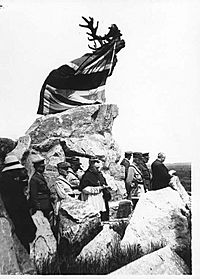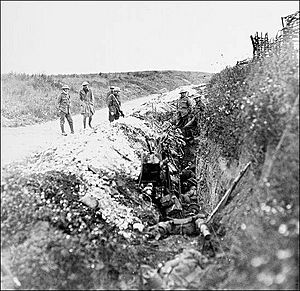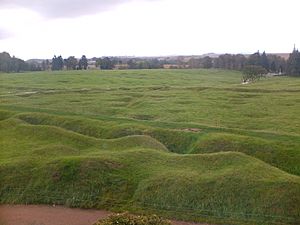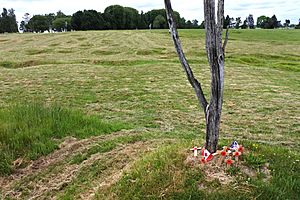Beaumont-Hamel Newfoundland Memorial facts for kids
Quick facts for kids Beaumont-Hamel Newfoundland Memorial |
|
|---|---|
| Veterans Affairs Canada Commonwealth War Graves Commission |
|

Caribou statue, Newfoundland Regiment Memorial, Beaumont-Hamel
|
|
| For the Newfoundland Regiment on the opening day of the Battle of the Somme and World War I Newfoundland forces members whose graves are unknown. | |
| Unveiled | 7 June 1925 |
| Location | 50°04′25″N 02°38′53″E / 50.07361°N 2.64806°E near Beaumont-Hamel, France
|
| Designed by | Rudolph Cochius (landscape) Basil Gotto (memorial) |
| Commemorated | 814 |
|
To the Glory of God and in perpetual remembrance of those officers and men of the Newfoundland Forces who gave their lives by Land and Sea in the Great War and who have no known graves.
|
|
| Statistics source: Cemetery details. Commonwealth War Graves Commission. | |
| Official name: Beaumont-Hamel Newfoundland Memorial National Historic Site of Canada | |
| Designated: | 1996 |
The Beaumont-Hamel Newfoundland Memorial is a special place in France. It remembers soldiers from Newfoundland who died during World War I. This 74-acre (300,000 m2) park is a preserved battlefield. It shows where the Newfoundland Regiment fought on July 1, 1916. This was the very first day of the Battle of the Somme.
The Battle of the Somme was the regiment's first big fight. In about 30 minutes, most of the regiment was lost. Newfoundland bought this land in 1921. It is the largest memorial for a single battalion on the Western Front. It's also the biggest preserved part of the Somme battlefield. You can still see old trench lines here. There are also many memorials and cemeteries on the site.
British Field Marshal Earl Haig officially opened the memorial in 1925. It is one of only two National Historic Sites of Canada outside of Canada. (The other is the Canadian National Vimy Memorial). This memorial and the Newfoundland Regiment's story at Beaumont-Hamel are very important. They represent Newfoundland's experience in World War I. It has become a symbol of sacrifice and a key part of Newfoundland's identity.
Contents
A Look Back at the War
During World War I, Newfoundland was a small country. It was a Dominion of the British Empire. It had about 240,000 people and was not yet part of Canada. When the war started in 1914, Newfoundland decided to create a fighting force. Even though they hadn't had a military since 1870, many men volunteered. They formed a whole battalion, which means a large group of soldiers.
The regiment trained in the United Kingdom. It grew from 500 men to 1,000. Then, they were sent to Egypt to get used to the conditions. After that, they fought at Suvla Bay in the Gallipoli Campaign. When that campaign ended, the regiment rested. In March 1916, they moved to the Western Front in France.
The Battle of the Somme
In France, the regiment got back to full strength. They were getting ready for the Battle of the Somme. The regiment was part of the 29th British Division. They arrived at Beaumont-Hamel in April 1916. Beaumont-Hamel was at the northern end of a 45-kilometer long battle line. British and French forces were attacking this line.
The attack was supposed to happen on June 29, 1916. But it was delayed by two days to July 1, 1916. This was partly because of bad weather. It also gave more time for artillery to bomb the enemy. The 29th British Division faced strong German defenses. These defenses were held by experienced German soldiers. The Germans had been in this area for almost two years. They had built many deep underground shelters and tunnels.
Before the main attack on July 1, 1916, a huge mine exploded. It was 18,000 kilograms (40,000 pounds) of explosives. This mine blew up under a strong German position called Hawthorn Ridge Redoubt. The explosion destroyed the enemy strong point. But it also warned the German soldiers that an attack was coming. After the blast, German troops quickly came out of their shelters. They were ready to fight.
When the attack began, the first British soldiers were quickly stopped. Most of them couldn't get past the German barbed wire. The commanders at headquarters were getting confusing messages. They thought some troops had broken through the German lines. So, they ordered the 88th Brigade, which was in reserve, to send more soldiers forward.
At 8:45 a.m., the Newfoundland Regiment was ordered to move. They were in a support trench called St. John's Road. This was about 250 yards (230 m) behind the British front line. They couldn't move through the communication trenches. These were blocked with dead and wounded soldiers and under enemy fire. So, their commander decided they had to go over the top. This meant crossing the open ground. They also had to get through their own barbed wire first.
As they climbed over the ridge, they were the only soldiers moving. The German defenders could see them clearly. The German machine guns fired heavily. Most of the Newfoundland Regiment soldiers were killed, dying, or wounded within 15 to 20 minutes. Many only made it as far as the Danger Tree. This was a broken tree in the middle of no man's land. It was used as a landmark.
About 780 men from the Newfoundland Regiment went forward. All the officers and almost 658 other soldiers became casualties. Only about 110 survived without injury. The next day, only 68 were able to answer roll call. The Newfoundland Regiment was almost completely wiped out. About 80% of their soldiers were lost.
It was a magnificent display of trained and disciplined valour, and its assault only failed of success because dead men can advance no further.
The Rest of the War
After July 1916, the Beaumont-Hamel area became quieter. The Battle of the Somme continued further south. On November 13, 1916, the 51st (Highland) Division attacked Beaumont-Hamel. Within two days, they captured all the areas the 29th Division had aimed for on July 1. They also took many German prisoners. The memorial site then became a safe area behind the front lines. Soldiers stayed in the old German dugouts.
In March 1917, the Germans moved back to the Hindenburg Line. This was about 30 kilometers from Beaumont-Hamel. People started to clear the battlefield. Many dugouts were closed. Some land was even returned to farming. However, in March 1918, the Germans attacked again. The fighting returned to the same battle lines. Until August 1918, the two sides faced each other here. But there were only small fights, patrols, and artillery fire.
History of the Memorial Site
In 1921, Newfoundland bought the land where the regiment fought. This was the site of their difficult attack on the first day of the Battle of the Somme. Much of the credit for creating this 74-acre (300,000 m2) memorial site goes to Lieutenant Colonel Tom Nangle. He was a former priest of the regiment. He helped buy the land from about 250 French landowners.
He also helped choose and develop the places where Newfoundland memorials now stand. He oversaw their construction. The memorials, including the one at Beaumont-Hamel, were built between 1924 and 1925.
The Beaumont-Hamel Newfoundland Memorial site officially opened on June 7, 1925. Field Marshal Earl Haig unveiled the main memorial. After Newfoundland joined Canada in 1949, the Canadian Government took over care of the site. This is done through Veterans Affairs Canada.
The site had been damaged during the German occupation in the Second World War. After 1949, the original building was replaced. Some trenches were also restored. This was done in time for the 45th anniversary of the battle. On April 10, 1997, the memorial site became a National Historic Sites of Canada. It is one of only two outside of Canada.
Exploring the Site
The Beaumont-Hamel Newfoundland Memorial site is about 9 kilometres (6 mi) north of Albert, France. It's near the village of Beaumont-Hamel. This area has many cemeteries and memorials from the Battle of the Somme. It's one of the few places on the old Western Front where you can still see the original trenches. The land has been kept in its natural state. It is the largest site dedicated to the Newfoundland Regiment. It's also the biggest memorial for a battalion on the Western Front.
The site honors the Newfoundland Regiment. But it also has other memorials and four cemeteries. These cemeteries are maintained by the Commonwealth War Graves Commission. They include Y Ravine Cemetery, Hawthorn Ridge Cemeteries No. 1 and No. 2, and Hunter's Cemetery.
Many people visit the site for battlefield tours. It's also important for studying World War I battlefields. This is because it is so well preserved. More and more visitors come each year. So, parts of the battlefield have been fenced off to protect them.
29th Division Memorial
Near the entrance to the site, there is a memorial to the 29th British Division. The Newfoundland Regiment was part of this division. Lieutenant-General Beauvoir De Lisle, who commanded the 29th British Division during the war, unveiled this monument. This happened on the morning of June 7, 1925, the same day the main site opened. Each unit from the 29th British Division sent a soldier to form a guard of honor. Later, these soldiers joined French infantry to form the honor guard for the main Newfoundland Memorial.
Newfoundland Regiment Memorial
This memorial is one of seven identical memorials built after World War I. Six were put up in France, Belgium, and at Bowring Park in St. John's, Newfoundland. The seventh is in Turkey. The one in Bowring Park was a gift, not a national memorial.
The memorial is a bronze caribou. A caribou is the symbol of the Royal Newfoundland Regiment. The caribou stands on top of a pile of Newfoundland granite. It faces the old enemy lines, with its head held high. At Beaumont-Hamel, the mound is about 50 feet (15 m) tall. The mounds are also surrounded by plants native to Newfoundland.
At the base of the Beaumont-Hamel memorial, there are three bronze tablets. They list the names of 820 members of the Royal Newfoundland Regiment. Also listed are those from the Newfoundland Royal Naval Reserve and the Mercantile Marines. These were soldiers and sailors who died in World War I and have no known grave. The memorial is near the headquarters dugout of the 88th Brigade. The Newfoundland Regiment was part of this brigade.
Sixteen designs for the memorial were suggested. Tom Nangle recommended that the government choose British sculptor Basil Gotto's plan. He suggested five identical caribou statues. Gotto was already known in Newfoundland. He had created the "Fighting Newfoundlander" statue in Bowring Park. Rudolph Cochius, a landscape architect from the Netherlands, designed the sites. He also oversaw their construction. They decided to plant many native Newfoundland trees. These included spruce, dogberry, and juniper. Over 5,000 trees were planted by 1925.
Field Marshal Earl Haig unveiled the memorial on June 7, 1925. Many important people were there. These included Marshal of France Marie Émile Fayolle, Newfoundland Colonial Secretary John Bennett, and several generals.
51st Division Monument
Overlooking Y Ravine is the memorial to the 51st (Highland) Division. The land first given for this memorial was unstable. This was because of many dugouts underneath. Lieutenant Colonel Nangle offered a spot within the Beaumont-Hamel Newfoundland Memorial site. This spot overlooked Y Ravine. The Y Ravine was where the 51st Division fought fiercely on November 13, 1916.
George Henry Paulin was chosen to sculpt the 51st Division Monument. The base of the monument is made of rough granite blocks. These came from Rubislaw quarry in Aberdeen, Scotland. They are put together in a pyramid shape. A soldier named Company Sergeant Major Bob Rowan was the model for the kilted figure on top. The figure faces east towards the village of Beaumont-Hamel.
On the front of the monument, there is a plaque with a Gaelic saying: La a'Blair s'math n Cairdean. In English, this means "Friends are good on the day of battle." Marshal of France Ferdinand Foch, who was the Allied Supreme Commander, unveiled the monument. This happened on September 28, 1924. The memorial was rededicated on July 13, 1958. The front panel now remembers those who died in both World War I and World War II. A wooden Celtic cross is also nearby. It was originally at High Wood and later moved here. This cross remembers the men of the 51st Highland Division who died at High Wood in July 1916.
The Danger Tree
The Danger Tree was once part of a group of trees. It was about halfway into no man's land. Newfoundland Regiment soldiers first used it as a landmark before the Battle of the Somme. British and German artillery fire eventually destroyed the tree. Only a broken trunk was left.
During the Newfoundland Regiment's attack, the tree was again used as a landmark. Soldiers were told to gather there. However, the tree was very easy for German artillery to see. Many soldiers were killed or wounded around this tree. Today, a replica of the twisted tree stands in the same spot.
Visitors Centre
There is a Visitors' Centre at the site. It shows what life was like in Newfoundland in the early 1900s. It also tells the story of the Royal Newfoundland Regiment and some of its soldiers. A special Memorial room inside the Centre holds a copy of the Newfoundland Book of Remembrance. It also has a bronze plaque listing the Battle Honours won by the Royal Newfoundland Regiment. The center also has offices and an archive. Canadian student guides work at the site. They can give tours and explain the battlefield and Newfoundland's role.
Newfoundland's Lasting Impact
The events at Beaumont-Hamel on the first day of the Battle of the Somme had a huge impact on Newfoundland. It was the first major conflict for this small country. Newfoundland felt a deep sense of loss that affected a whole generation.
The war also caused financial problems for Newfoundland. They had a large debt from the war. There was also a long economic slowdown after the war, especially in the fishing industry. These problems made the impact of the war even harder.
The war experience still has a lasting effect on the island. In Canada, July 1 is celebrated as Canada Day. This day marks when Canada became a country. But in the Canadian province of Newfoundland and Labrador, July 1 is Memorial Day. It remembers the Newfoundland Regiment's losses at Beaumont-Hamel.
Memorial University of Newfoundland was first created as a memorial. It honors Newfoundlanders who died serving in World War I. Finally, there are the seven caribou memorials and the National War Memorial. These were built after World War I. The preserved battlefield park at Beaumont-Hamel is visited by thousands of people every year. The Beaumont-Hamel Newfoundland Memorial site also helps teach visitors about the Newfoundland Regiment's experience and the island's history.
Images for kids






